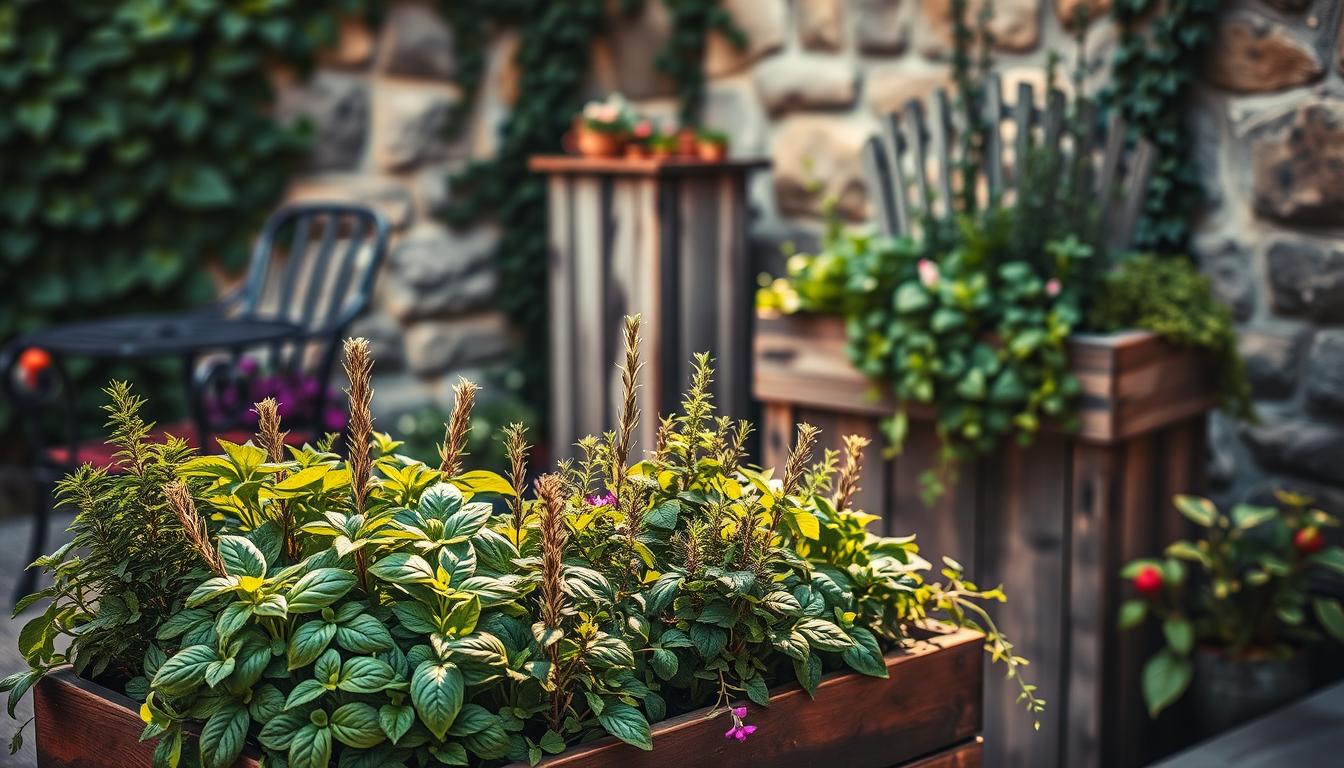
Patio Edible Herbs
Imagine stepping out into your backyard and picking fresh herbs for dinner. Growing your own organic herbs on your patio is rewarding. It gives you fresh flavors and greenery right at home.
This hobby not only makes your food better but also makes your outdoor space more peaceful. With a bit of care, you can have a lot of tasty and healthy edible herbs.
Welcome to the world of patio edible herbs. Here, gardening and cooking come together. We’ll look at the best herbs to grow, how to take care of them, and how to use them in your cooking.
Introduction to Edible Herbs
Edible herbs add flavor to your meals and are nutritious when grown at home. They are versatile, making dishes taste fresh and delicious.
What Are Edible Herbs?
Edible herbs are plants with leaves, stems, or roots used in cooking. They add flavor without salt or sugar, making them a healthy choice.
Benefits of Growing Edible Herbs
Growing your own herbs is rewarding. You get fresh ingredients and control over their growth, avoiding chemicals. It’s also a calming hobby.
Why Choose a Patio Garden?
A patio garden is perfect for growing herbs, even with little space. It turns your outdoor area into a productive, beautiful space. With the right care, your patio can flourish with herbs.
By growing herbs on your patio, you enhance your cooking with fresh flavors. You also add a delicious and nutritious touch to your meals.
Best Edible Herbs for Your Patio
Creating a culinary haven on your patio starts with the right herbs. These herbs bring flavor and freshness to many dishes. They’re essential for anyone who loves to cook.
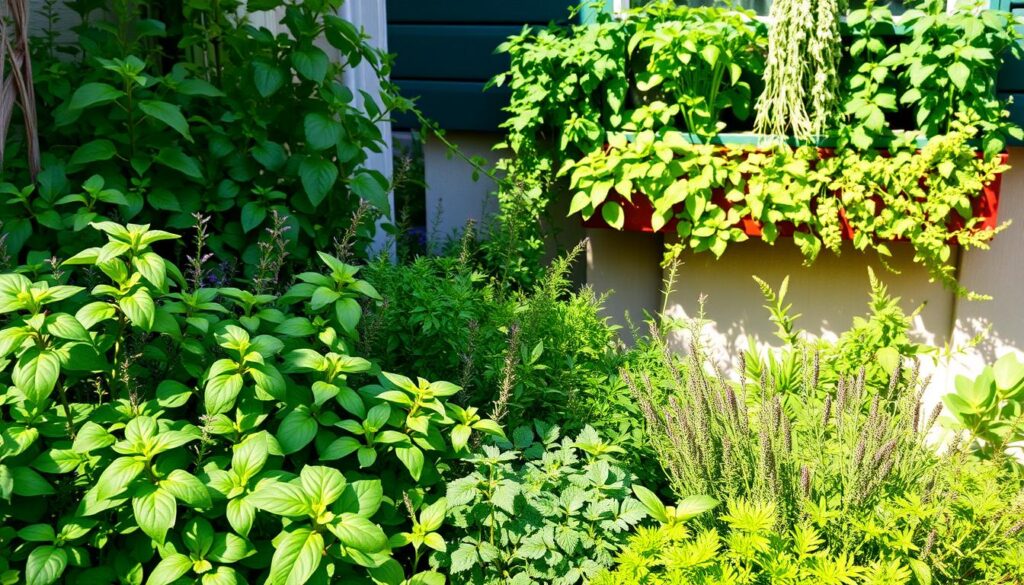
Choosing the right herbs can make your cooking better. They provide a constant supply of tasty ingredients. Here are some top edible herbs for patio gardens.
Basil: A Versatile Favorite
Basil is a favorite for patio gardens. It’s versatile in many dishes, like pesto and caprese salads. It adds a unique flavor that’s hard to find elsewhere. Basil is easy to grow in containers with the right care.
Parsley: The All-Purpose Herb
Parsley is great for patio gardens. It’s fresh and nutritious, perfect for garnishes, salads, and soups. It’s easy to care for and grows well in partial shade. This makes it a versatile choice.
Mint: Freshness and Flavor
Mint adds a cooling flavor to drinks and desserts. It’s also good for digestion and can be used in teas or as a garnish. But mint can spread, so grow it in containers to keep it in check.
These herbs not only flavor dishes but also beautify your patio garden. Mixing different herbs creates a vibrant and useful outdoor space.
How to Grow Edible Herbs on a Patio
To enjoy fresh, edible herbs, you need to know the basics of patio gardening. Growing consumable herbs in containers is rewarding. It gives you organic produce right at your doorstep.
Choosing the Right Containers
Start by picking the right containers for your herb garden. Make sure they have holes for drainage to avoid waterlogged soil. The size of the container depends on the herb’s growth. For example, mint needs more space because it spreads a lot.
Soil and Drainage Considerations
It’s important to use a well-draining potting mix for your herbs. A mix made for containers prevents root rot and helps roots grow well. Adding organic matter like compost improves soil fertility and structure.
Sunlight and Water Needs
Most edible herbs need lots of sunlight to grow well. Make sure your patio gets at least 4-6 hours of direct sunlight a day. Watering varies by herb, but a good rule is to water when the top inch of soil feels dry. Avoid overwatering, as it’s a common mistake.
Caring for Your Edible Herbs
Taking care of your edible herbs is key to a great harvest. They add nutritious and delicious flavors to your dishes. Regular care keeps them healthy and productive all season.
Fertilizing Edible Herbs
Fertilizing is crucial for your herbs’ growth. Most herbs need a balanced fertilizer once a month. But, each herb has its own needs, so check them out.
Basil and mint need more food, while rosemary and thyme need less. A soil test can show what your soil needs, helping you fertilize right.
| Herb Type | Fertilization Frequency | Special Considerations |
|---|---|---|
| Basil | Monthly | Benefit from high nitrogen levels |
| Mint | Monthly | Can be invasive; keep contained |
| Rosemary | Every 2 months | Drought-tolerant; avoid overfertilizing |
Pruning Techniques for Healthy Growth
Pruning is essential for bushy growth and to stop herbs from getting too long. It also helps the roots grow, making plants healthier. Cut off flower buds to focus on leaves, and trim long stems to encourage new growth.
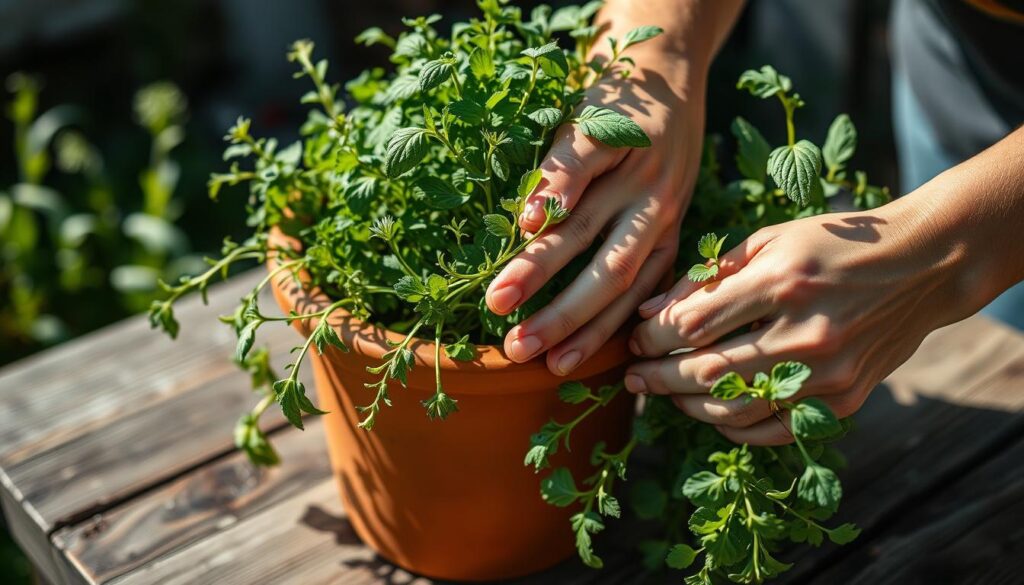
Recognizing Pests and Diseases
Check your herbs often to spot pests and diseases early. Common pests are aphids, spider mites, and slugs. Fungal diseases can also be a problem, especially in damp weather.
Use natural pest control whenever you can. Remove any sick plants or parts to stop disease from spreading. Good air flow and avoiding overhead watering can also help prevent problems. For tough issues, try neem oil or insecticidal soap.
Harvesting Your Edible Herbs
To enjoy your patio herb garden, knowing when and how to harvest is key. Harvesting at the right time gives you the best taste and smell. This makes your food tasty and fun to eat.
Harvesting times vary by herb type. Leafy herbs like basil and mint are best before they flower. Herbs like parsley and cilantro can be picked many times during their season.
When to Harvest for Best Flavor
Each herb has its best harvesting time. For example, chives and dill are ready when they’re big enough. Knowing what your herbs need is important for their consumable quality.
| Herb | Optimal Harvest Time | Tips |
|---|---|---|
| Basil | Just before flowering | Pinch off flower buds to encourage leaf growth |
| Mint | Before flowering | Regular harvesting encourages bushy growth |
| Parsley | Continuously throughout the season | Harvest outer leaves to promote new growth |
Proper Harvesting Techniques
Right harvesting techniques are vital for your herb plants’ health. For most herbs, pinching or cutting off leaves or stems helps. It encourages new growth and stops the plant from flowering too soon.
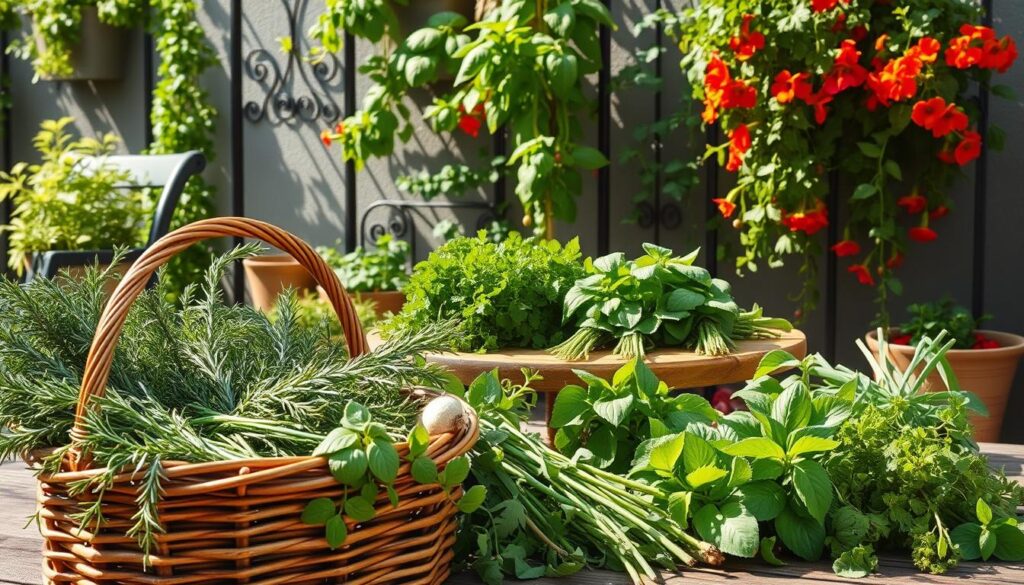
Preserving Your Harvest
To enjoy fresh herbs all year, preserving them is a good idea. Drying, freezing, and making herb-infused oils are great ways. They keep your herbs fresh for longer.
By following these tips, you can have a steady supply of fresh herbs. This will make your cooking better and help you enjoy your herb garden more.
Culinary Uses of Edible Herbs
Exploring edible herbs in cooking is a fun journey. Herbs from your patio can boost flavors and aromas in many dishes. They can change a simple meal into something special.
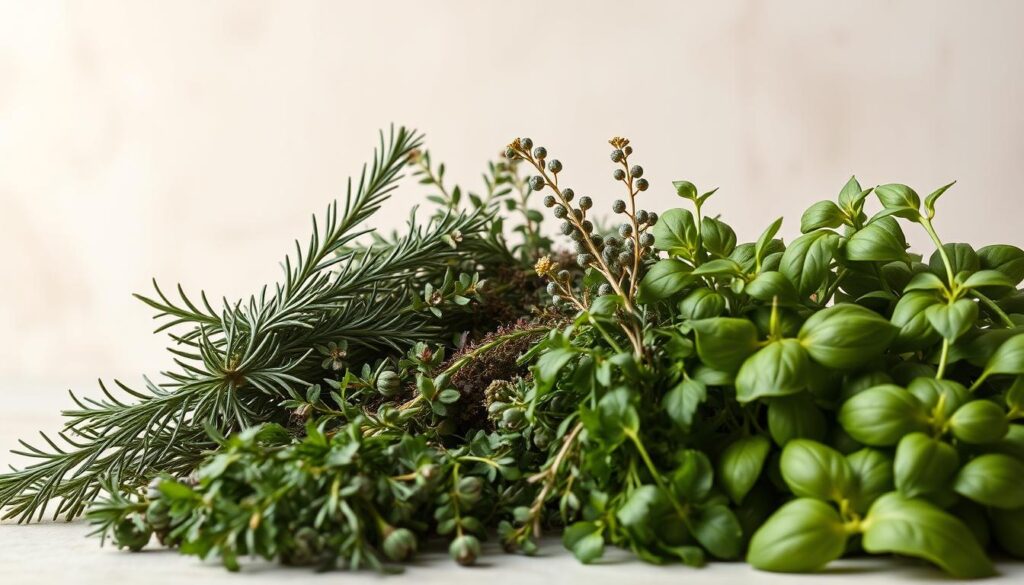
Cooking with Fresh Herbs
Adding fresh herbs to your meals adds depth and complexity. Herbs like basil, parsley, and mint are great for salads, soups, main dishes, and even desserts. Fresh herbs should be chopped and added near the end of cooking to keep their flavors and scents.
Infusing Oils and Vinegars
Infusing oils and vinegars with herbs makes delicious condiments. These can be used in cooking and as gifts. Choose the right herbs, prepare them, and let them infuse in the oil or vinegar.
Creating Herbal Teas
Herbal teas are a calming, caffeine-free drink. Herbs like mint and parsley make great tea. Herbal teas can be enjoyed hot or cold, with or without sugar. To make them, pick the right herbs, dry them if needed, and steep in hot water.
Using edible herbs in cooking opens up a world of flavors. Whether you’re cooking, making infused oils and vinegars, or herbal teas, the options are endless and tasty.
Pairing Herbs with Dishes
Unlock the full potential of your edible herbs by pairing them with complementary dishes. The right combination can turn a simple meal into a culinary masterpiece. It adds nutritious value and makes it incredibly tasty.
Certain herbs pair well together, creating delicious and harmonious flavor combinations. These pairings can enhance your cooking. Understanding these pairings is key to making the most out of your herb garden.
Best Herb Combinations
Some herbs complement each other beautifully, creating complex flavors. For example, basil and oregano form a classic combination that works well in Mediterranean dishes. Parsley and dill can be paired to add freshness to salads and sauces.
Experimenting with different herb combinations can lead to the discovery of new flavors. A mix of mint and lemongrass, for instance, can create a refreshing and aromatic flavor profile perfect for summer dishes.
Enhancing Flavors in Main Dishes
Herbs can significantly enhance the flavors in main dishes, adding a burst of freshness and flavor. For example, rosemary can be used to season roasted meats, while thyme can add depth to soups and stews.
When cooking main dishes, consider the type of protein or vegetable you’re using. Choose herbs that complement their natural flavors. For instance, chicken pairs well with herbs like sage and parsley, while fish can be enhanced with dill or tarragon.
Herb-Infused Side Dishes
Even side dishes can be transformed with the addition of herbs, creating delicious and aromatic accompaniments. Roasted vegetables, for example, can be seasoned with herbs like rosemary or thyme to add flavor.
Herb-infused oils can also be used to dress salads or as a finishing touch for roasted vegetables. Consider infusing olive oil with herbs like basil or oregano for a Mediterranean twist.
Seasonal Considerations for Patio Herbs
To keep your patio herb garden thriving, knowing how seasons affect it is key. Different herbs do best in various conditions. Knowing these differences helps you optimize your garden.
Growing Herbs Year-Round
Some herbs can’t handle frost and grow only in warmer months. Herbs like rosemary and thyme are hardy and can survive winter with the right care. To grow herbs all year, pick varieties that match the season and give them the right conditions.
In cold months, move plants to a sheltered spot or use a cold frame. In warmer months, make sure they get enough sunlight and water.
Seasonal Herbs to Try
Each season offers unique herbs for your patio. In spring, grow chives and parsley in the cooler weather. Summer is perfect for basil and mint in the warmth. For autumn, plant cilantro and dill. In winter, focus on sage and rosemary.
Trying seasonal herbs keeps your garden lively. It also means you always have fresh herbs for cooking.
Preparing for Frost and Cold Weather
When it gets colder, prepare your herb garden for frost. Move sensitive herbs indoors or to a safe spot. Use mulch or straw to keep the soil warm and protect roots.
For frost-sensitive herbs, propagate them indoors in winter. This way, you can enjoy fresh herbs even when it’s cold.
Understanding your herbs’ seasonal needs and protecting them ensures a year-round harvest. This way, you’ll always have delicious, consumable herbs.
Common Mistakes in Growing Edible Herbs
Growing edible herbs can be a fun experience. But, there are common mistakes that can stop you from succeeding. Knowing these mistakes can help you grow a healthy patio garden with organic and culinary delights.
Understanding the common mistakes in growing edible herbs is key. By knowing these errors, you can fix them and make sure your herbs grow well.
Overwatering and Underwatering
Improper watering is a common mistake in growing edible herbs. Both overwatering and underwatering can harm your plants. Overwatering can cause root rot, while underwatering can stress the plants and lower herb quality.
To avoid these problems, learn what your herbs need in terms of water. Most herbs prefer well-draining soil and should be watered when the top inch of soil feels dry.
Ignoring Pest Problems
Ignoring pest problems is another mistake. Pests can damage your edible herbs, making them less flavorful and nutritious. Check your plants often for pests like aphids, spider mites, or caterpillars.
Using organic pest control methods is a good way to deal with pests. Neem oil and insecticidal soap are effective against many herb pests.
Not Harvesting Regularly
Not harvesting your herbs regularly is another mistake. Regular harvesting helps your herbs grow bushy and prevents them from flowering and going to seed.
Harvesting your herbs often means you’ll always have fresh, flavorful leaves. It also keeps your plants healthy and in shape.
Resources for Edible Herb Enthusiasts
Edible herbs open a world of flavors in cooking. For those eager to dive in, many resources are available. Whether you’re a seasoned gardener or new to the field, learning more about edible herbs can make your gardening and cooking better.
Books on Herb Gardening
Books are a great source for deep knowledge on growing and using herbs. “The New Seed Starter’s Handbook” by Nancy Bubel and “Herb Gardening For Dummies” by Karyl Weinburg are excellent choices. They cover everything from the basics of growing herbs to advanced cooking techniques.
Key topics covered in herb gardening books include:
- Soil preparation and maintenance
- Propagation techniques for various herbs
- Pest management and common issues
Online Communities and Forums
Online forums and communities are great for connecting with other herb lovers. Sites like GardenWeb and Reddit’s r/gardening are perfect for sharing experiences and getting advice. These platforms are great for solving herb-related problems and learning new things.
Some popular online platforms for herb enthusiasts include:
- GardenWeb forums
- Reddit’s r/gardening and r/herbalism
- Specialized Facebook groups for herb gardeners
Local Gardening Workshops
Local gardening workshops offer hands-on learning and expert advice. Many community gardens, nurseries, and botanical gardens host classes on herb gardening. These workshops teach practical skills like planting and harvesting, as well as advanced topics like pairing and preserving herbs.
Benefits of attending local workshops include:
- Practical, hands-on experience
- Expert advice tailored to your local climate and conditions
- Opportunities to network with local gardening communities
Conclusion: Enjoy Your Patio Edible Herb Garden
Growing edible herbs on your patio is rewarding. It gives you fresh herbs to make your food taste better.
Nourishing Your Culinary Passions
A patio garden lets you add fresh flavors to your cooking. Whether it’s a salad or a sauce, herbs can really improve taste and smell.
Starting Your Edible Herb Journey
Begin with easy herbs like basil or mint if you’re new. As you get better, add more herbs to your garden.
Tips for a Thriving Patio Herb Garden
For a great garden, give your herbs enough sunlight, water, and food. Also, pick your herbs often to keep them healthy and bushy.
Leave a Reply